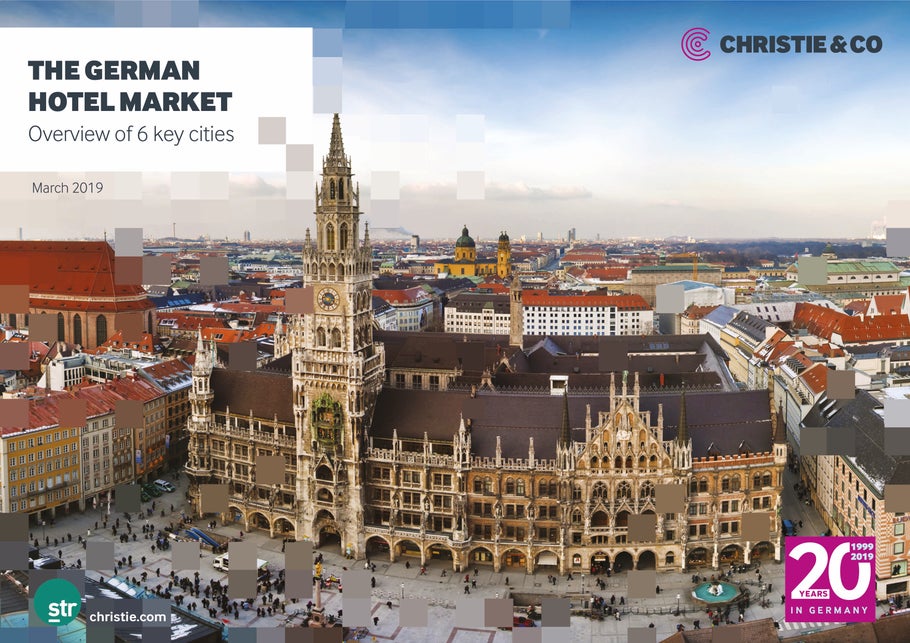German Hotel Market 2018
Continued demand leads to strong pipelines. Specialist business property adviser, Christie & Co has released its annual report. An overview of 6 key cities’, analysing the six top hotel markets in Germany.
Business. Built around You.
Christie & Co has provided valuable advice to clients within our specialist sectors for over 80 years.

Berlin/Frankfurt/Munich. Specialist business property adviser, Christie & Co has released its annual report ‘The German Hotel Market: Overview of 6 key cities’, analysing the six top hotel markets in Germany. The report looks at how tourism in Berlin, Munich, Frankfurt am Main, Hamburg, Cologne and Dusseldorf developed in 2018.
The German hotel market has been flourishing for years and the report shows that for the ninth consecutive year, overnight numbers have increased on the previous year. However, not all cities performed as strongly as others – who won last year’s performance race and who will need to catch up in 2019?
The capital, Berlin is not only Germany’s largest city, it is also the largest hotel market with more than 121,000 beds and 27.1 million overnights in 2018. In the last five years, bed supply increased by 10.7% and overnights grew by 14.9%. While the first half of the year performed on the average, KPIs went above and beyond in the following months due to multiple trade shows and events. At the end of the year, RevPAR was noted at €79 or 6.9% higher than in 2017, which is the largest RevPAR growth among the observed cities.
Demand measured in overnights in the Bavarian capital, Munich has grown 7% year-on-year since 2014, which equals the largest relative demand growth among the cities analysed. This proved to be an extraordinary result, particularly considering that Munich, with an average daily rate of €129 in 2018, is the most expensive city of those analysed. The city recorded 16.1 million overnights, half of which came from foreign visitors. After a weak first quarter, RevPAR growth set off in April and reached a peak in September and October. Demand boosters were multiple trade fairs as well as the annual Octoberfest. Year ending, RevPAR was at €96 or 4.2% higher than in 2017.
Frankfurt am Main is a popular business destination and financial hotspot. These advantages were reflected in the city’s 2018 tourism statistics as the banking city registered almost 10 million overnights. Alongside the growing demand, bed supply also increased, breaking the 50,000 rooms mark. Together with fewer demand peaks and a disappointing Q4, performance deteriorated slightly and at the report highlights an average €83 RevPAR, made up of both a lower occupancy (69%) and a lower average rate (€120).
After Hamburg has been outperforming itself year on year, this year’s report saw the port city at the Elbe river pass the RevPAR leader crown back to Munich. Now runner-up among the six cities, its RevPAR reached €92 (-2.5%) in 2018. Neither occupancy nor rate remained unscathed. While bed supply has increased by 21.4% since 2014, overnights grew by just 20.1%. It would be premature to assume oversupply, however the 12,000 rooms in the pipeline are likely to increase competitive pressure and expedite market consolidation.
Cologne is a popular MICE destination as around 40% of demand can be backtracked to this segment. As such, performance is shown to react in tandem to changes in the fair and congress calendar. 2018 ended with a lower RevPAR of €82 for the carnival city, down 4.8% compared to 2017 levels, even though demand increases outpaced supply growth (2.4% per year versus 0.3% per year). Currently, there are c.1.700 rooms in the pipeline and planned future trade fairs are expected to fuel its 2019 performance.
While the report shows that the number of hotels and B&Bs remained fairly stable in Dusseldorf over the last five years, bed supply has increased by 12%. Over the same period, demand growth measured in overnights remained below supply growth at 11.4%. Like Cologne, Dusseldorf is strongly dependant on the trade fair cycle and thus, RevPAR is shown to typically slump during holidays and off-fair periods, peaking during event and fair days. Due to fewer such peaks in 2018, RevPAR was down 7.8% to €76 compared with the city’s 2017 result.
According to Christie & Co’s report, the German hotel market is still going strong. Many key metrics underline the market’s strength, and investors’ interest in the top six cities remains high. The continuing demand surge reflects their attractiveness and even as supply is increasing, most cities seem poised to absorb this supply in the medium term. Like 2018, the top six expect considerable supply increases, which may lead to below average performance growth in the short run. Depending on the trade fair cycle in some markets, such growth may even be deferred to 2020.
Lukas Hochedlinger, Managing Director – Central & Northern Europe at Christie & Co comments, “The German hotel market could once again shine in 2018, as demand continues to grow, and the market remains attractive for investors. However, we expect competition to increase, as the report highlights the high number of rooms in each city’s pipeline. Nevertheless, increasing yields or a higher risk aversion cannot be observed to date.”
Patrik Hug, Senior Consultant Advisory & Valuation Services adds, “Currently, branded limited service hotels are most sought-after. Aparthotels have become tradable for institutional investors and are successful due to their lean cost structure. New concepts that combine co-working, sleeping, socialising and innovative food concepts are moving into the German market to meet the digital native’s needs, where the large hotel chains lack agility. Berlin and Munich continue to be prime spots on many wish lists for development, however we expect a greater diversity and interest in the other cities as well.”